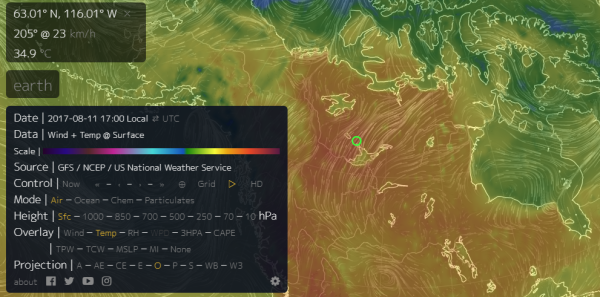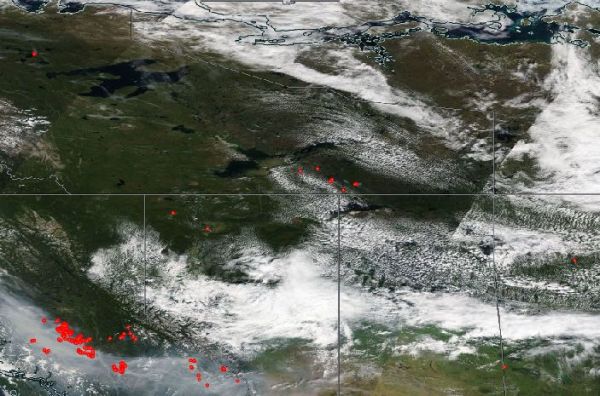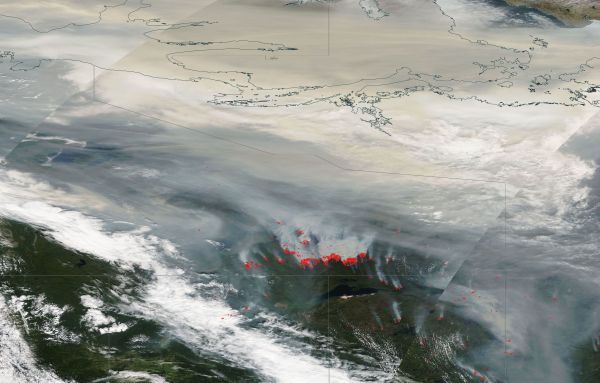Area Burned in Severe Northwest Territory Wildfires Doubles in Just One Day
Robertscribbler,
15
August, 2017
In
just one day, an area of land covering 1,860 square miles of the
Northwest Territory has burned. That’s a zone 50 percent larger
than the entire state of Rhode Island going up in smoke over just one
24 hour period. And as you can see from the GOES satellite animation
below, the volume of smoke being produced by fires burning in a
permafrost thaw region is quite extreme:
Incredible amounts of smoke being generated by #wildfires south of #GreatSlaveLake in #Canada - #GOES16 - preliminary and non-operational
*****
Over
the past week, the Arctic and sub-Arctic Northwest Territories (NWT)
of Canada have been baking under an intense late-summer heatwave. At
a time when NWT temperatures should be cooling down from July peaks,
most days of the past seven have seen the mercury rise into the upper
80s and lower-to-middle 90s (Fahrenheit).
These
10-35 degree (F) above average temperatures sweltered coniferous
forests, peat bogs and thawing permafrost. The high temperatures also
unleashed Arctic and sub-Arctic thunderstorms. A new breed of weather
for this typically cool zone. One that has been enabled by a
human-forced warming of our world through fossil fuel burning —
causing temperatures in the Arctic to warm twice as fast as the rest
of the globe.
(Extreme
heat in the range of 95 degrees F [35 C] blankets the Northwest
Territories on August 11, 2017 — drying vegetation and promoting
wildfire producing lightning strikes. Image source: Earth
Nullschool.)
As
lightning strikes rained down over forests and peatlands unprepared
for such intense warmth and energy, large fires began to spark. These
fires were not yet as visible from the satellite as their, at the
time, larger British Columbia brethren (lower left in the image
below). But they were in a far northern region that has a recent if
rather anomalous history of rapid fire expansion. And already, wispy
plumes of smoke were becoming visible even in the wider-angle
satellite shots.
Up
until August 7th, fires in the Northwest Territory region of Canada
had been a bit moderate compared to recent years. In total, about
330,000 hectares had burned throughout 2017.
This put the region slightly above the 25 year average for fires, but
well behind the more intense rates of burning seen in recent years.
As of yesterday (August 14th), this number had climbed to 442,000
acres — exceeding the 15 year average, but still behind the more
intense 5 year average.
(Intense Northwest Territory Wildfires begin to spark on August 7th of 2017. These fires are visible near center frame. Note intense fires burning in British Columbia at lower left. For reference, bottom edge of frame is approx 1,200 miles. Image Source: NASA Worldview.)
At
this time, however, the satellite imagery was starting to look quite
ominous (see image below). Very large and intense rings of fire were
starting to expand north of Uranium City. And these fires were
casting vast thick and inky plumes of smoke up and over much of
Northern Canada. Their visible size and intensity hinted that
something pretty extreme was happening on the ground.
As
the fires appeared to explode in size, the various wildfire monitors
began to check in. In just one day, according to the most recent NWT
Current Fire Situation Report, these
massive fires more than doubled the total amount of land burned with
924,000 hectares now listed as consumed. This is roughly 3,565 square
miles — or about the size of Delaware and Rhode Island combined.
With an area fifty percent larger than the size of Rhode Island
(1,860 square miles) being consumed in just one day.
(Very intense wildfires burning on August 14 rapidly expanded to consume a section of territory larger than Rhode Island in just one day. For reference, bottom edge of frame is approx. 1,000 miles. Image source: NASA Worldview.)
Meanwhile,
land area burned for the Northwest Territory is now above the 5 year
average. With these fires burning so intensely, and with hot
conditions still on tap for next 48 hours, this already large burn
area could continue to rapidly expand.
Much
of this burning is occurring along a vast line of wildfires
stretching for 200 miles south of Great Slave Lake. In other words,
this is a fire line long enough to stretch the distance between
Norfolk, Virginia and Myrtle Beach, South Carolina. And the very
dense smoke plumes being emitted by these amazingly large fires are
likely to ultimately encircle the globe.
(Two
hundred mile line of fires south of Great Slave Lake has completely
blocked out satellite visual of the lake from orbit. Image
source: NASA
Worldview.)
Rainfall
and cooler conditions by Friday might tamp down these blazes. But the
situation at this time appears to be quite severe. Thankfully, unlike
the terrible fires that have consumed hundreds of homes and forced
tens of thousands to evacuate in British Columbia this summer or the
Fort McMurray Fire of 2016 which forced the emptying of an entire
city, these massive Northwest Territory fires are presently burning
in remote areas.
However,
the rapid expansion, large size and vast smoke plumes of these fires
bear a grim testament to the fact that the fire regime has vastly
changed for the worse in the Arctic nation of Canada. A situation
that will continue to dramatically intensify so long as fossil fuels
keep being burned.
(UPDATED)
Links:
Hat
tip to Shawn Redmond
Hat
tip to Spike








No comments:
Post a Comment
Note: only a member of this blog may post a comment.